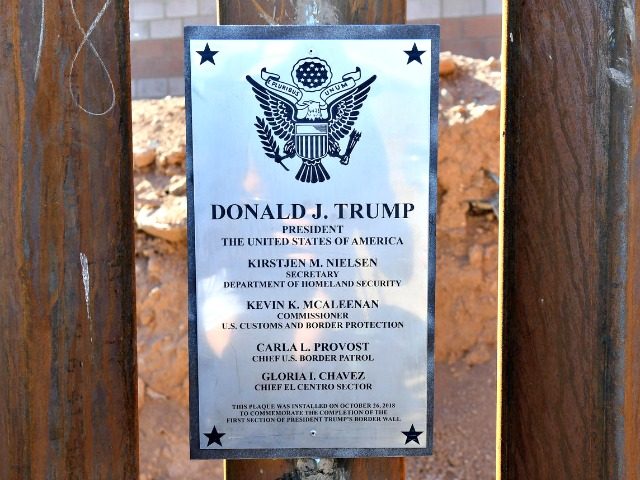Acting homeland security chief Kevin McAleenan is defending the agency’s apparent policy of upgrading — not lengthening — the border wall, saying the replacement of existing fencing was the agency’s top priority.
The defense comes as media outlets and White House officials are trying to learn if the agency has used any of the 2017, 2018, and 2019 border-wall funding to extend the existing fence into the border zones which have no fencing. Breitbart News reported May 22:
DHS, though, has refused for months to reveal the mileage of border wall that has been constructed at the southern border in areas that did not previously have barriers built. Breitbart News has made multiple requests to CBP officials, as well as a high-ranking DHS official, over the last two months and has yet to confirm the total mileage of new border wall on new land.
…
This week, a lawyer for the [Democrats in the] House of Representatives told an Oakland, California judge that less than two miles — 1.7 miles, exactly — of the border wall has been built at the southern border using the $1.57 billion that Congress allocated to the project last year.
McAleenan defended the upgrade-not-extension policy during a May 23 hearing held by the Senate’s Homeland Security Committee.
Oklahoma GOP Sen. James Lankford used his time to give McAleenan an opportunity to push back against the growing coverage of the wall-building policy. He asked a softball question about the effectiveness of the new fencing: “How is it working compared to old fencing?”
“A complete difference,” said McAleenan, continuing:
I’m glad you’ve asked that questions because there has been a lot of reporting that suggests this is not a new capability, this is just replacement, this isn’t helpful, this wasn’t important border wall. It could not be further from the truth. Those were our top requirements. We have this dilapidated wall, this was the first wall built because it was needed the most. In San Diego and El Centro sector, for instance, now having a 30-foot wall in El Centro sector where there is a mall within 40 yards of the border has completely changed that dynamic. The traffic has dropped off the table in that area and we are able to deploy and use our agents more efficiently in other parts of the sector … The percentage drop has been dramatic.
Lankford asked for effectiveness data to so he can also defend the upgrade-not-extension policy, saying:
We’d like to be able to see that because obviously, there has been a lot of pushback to say ‘This is replacement so it makes no difference.’ The numbers that I’ve seen on a preliminary basis show a pretty significant difference between the new fencing and between the older fencing that was not very effective at all.
Watch the question and answer here at 1:27:50.
Bloomberg reported:
A May 20 report by Customs and Border Protection on the status of the border wall specified that the $1.5 billion in 2018 funding is being used to update or build 80 miles of the border wall … $6.1 billion in funding has been committed since 2017 for the wall, both to Customs and Border Protection and the Defense Department, for 336 miles, according to the report.
Throughout the May 23 hearing, McAleenan’s focused on steps that the DHS is taking to streamline the movement of asylum-seeking migrants into U.S. asylum courts, and to block the smuggling of drugs via the “Ports of Entry” and between those openings.
His statements showed little concern for the impact of cheap labor migration on Americans’ workplaces, schools, and government budgets.
But the migration of Central Americans through his agency since 2017 has delivered at least 500,000 extra laborers to the blue-collar labor market, so reducing pressure on employers to boost Americans’ wages, working conditions, and productivity.
During the hearing, McAleenan pointedly excluded American workers from his description of the agency’s priorities. He commended the politically divided committee, saying, “I know the committee works in that [non-partisan] spirit… Our frontline agents and officers need it, they deserve that support of this committee, the [migrant] children being put at risk do as well, and the security of our border and the future of the region depend on it.”
The Senators did not address the workforce issue.
In 2017, Lankford praised the inflow of illegals, saying they are good for employers. In a 2017 press conference, for example, he said on video:
The job issue is an interesting issue, because those individuals are already in the job market. Many of these DACA students are actually DACA young adults, they already have access to the job market right now because they’ve been given deferred action. So they are in higher education, they are in the job market, they are currently a part of our economy, currently. That continual competition in our economy doesn’t hurt us, that continues to help us. It actually hurts us to put those individuals out of the economy.
GOP Sen. Ron Johnson, chairman of the Senate’s homeland security committee, has also pushed proposals to dramatically increase the inflow of foreign workers.

COMMENTS
Please let us know if you're having issues with commenting.